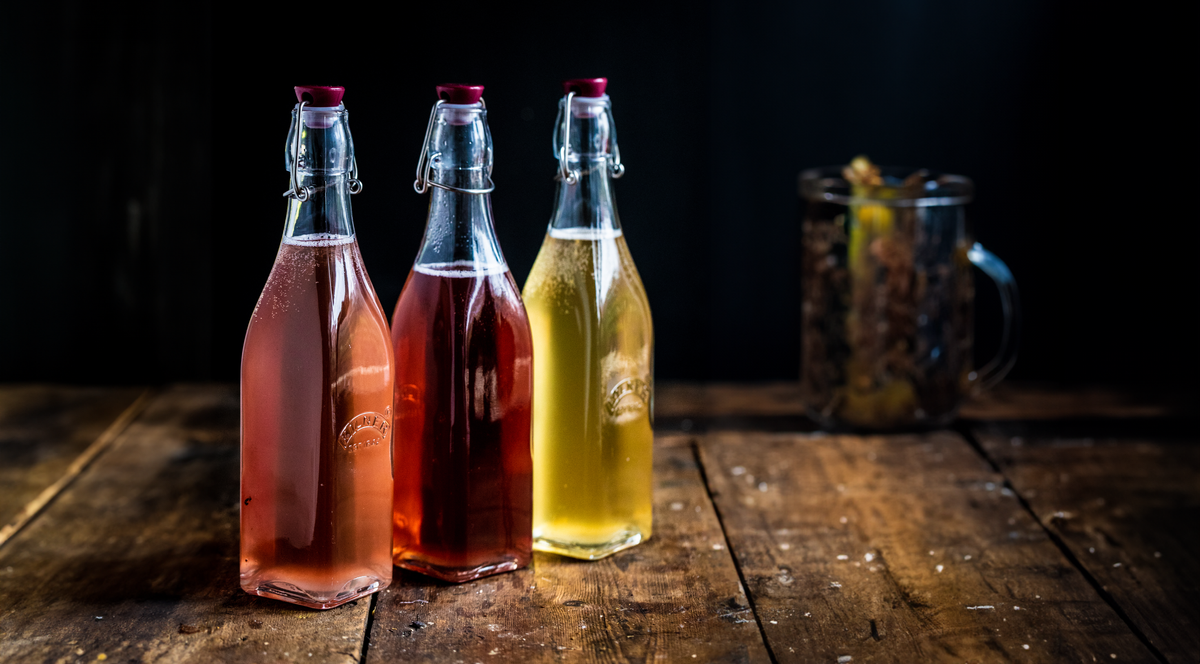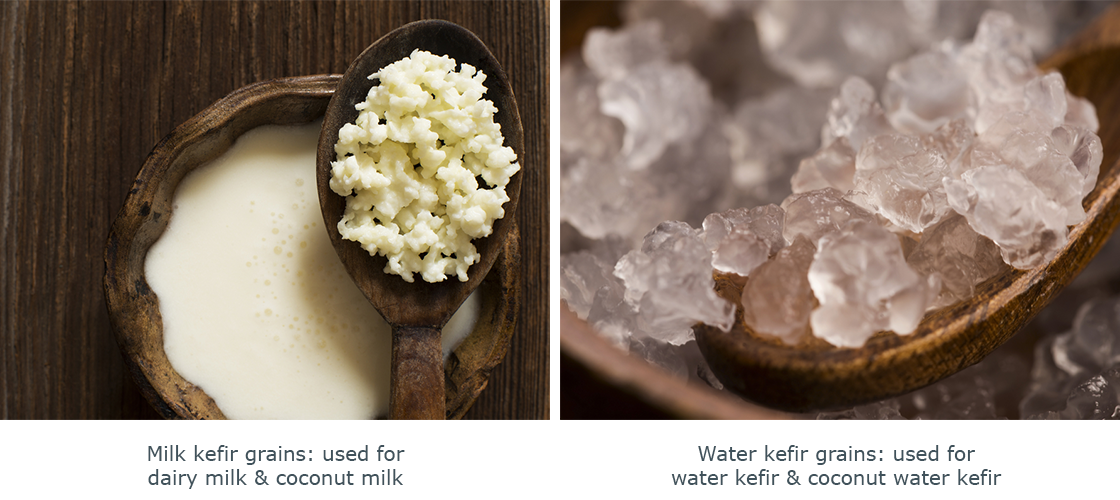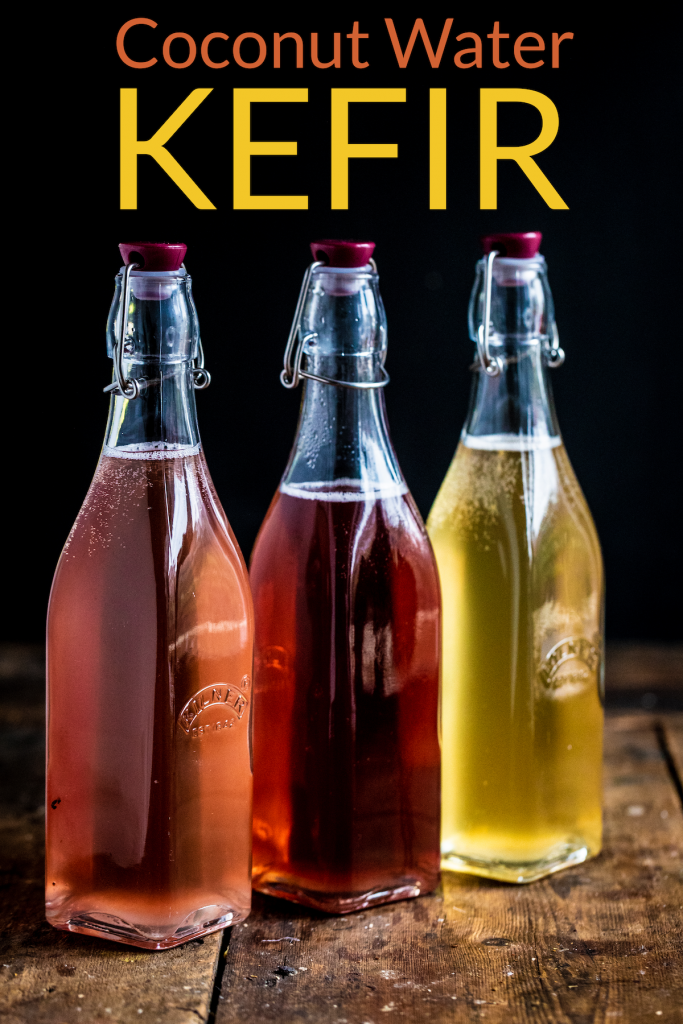How To Make Fizzy Coconut Water Kefir
Fizzy coconut water kefir is a lovely drink that can replace sugary drinks in yours or your family’s diet. In this lesson, we’ll show you how to make it in a variety of flavours.

Coconut Kefir & Water Kefir
Water kefir (“keh-fear”) grains — also called sugar kefir, tibicos, tibi, Japanese water crystals — are similar to kefir grains, which are used in dairy milk to make a fermented dairy drink.
In this article I’ll be giving you a recipe for coconut water kefir and water kefir. The first is one you make with coconut water from a young coconut, the second is one you make with filtered water.
Kefir Grains
Dairy kefir uses different grains (which are not grains like wheat grains – the word is used as it is in a grain of sand) to water kefir. If you want to make the type of coconut kefir that uses the meat from the coconut too, which results in a white kefir, rather than a translucent kefir, I’ll will be adding a video and recipe for that shortly (I’m writing this in April 2019).
Water kefir grains tend to be translucent, whereas milk kefir grains will be whiter, looking a little bit like cauliflower. Because water kefir grains tend to be used in a variety of liquids, they will sometimes appear different colours, depending on the colour of the liquid. So in the video for fizzy coconut kefir below, I use dark molasses and coconut sugar, which turns them brown. If you use white sugar, they’ll turn white.
No two batches of water kefir drink or grains are exactly the same in their bacterial makeup. This also means that you may find some variance in taste between two batches that you make, even with the same grains.
Like kefir grains, water kefir grains are a mix of bacteria and yeasts, which feed on the sugar in many different sugary liquids to produce lactic acid, very small amounts of ethanol (alcohol), and carbon dioxide, which carbonates the drink on the second stage fermentation, as I show in the video.
The main benefit of this process is that probiotics are produced in the final drink. It’s thought these are beneficial to the human intestines, creating an environment that aids digestion.
This is a great TedTalk about the science of your gut. . .
Growing Water Kefir Grains
Water kefir grains cannot be grown from scratch; they have to come from a donor. The good news is that you only need a very small amount to start growing them from that first batch. It seems there is an abundance of kefir grains for sale on eBay. You’ll only get very small amounts, but that’s all you need to start them multiplying.

Related: Raw Fermentation at Home online course
Water Kefir Recipe
Things to look out for with coconut water kefir
- I used to think you need to rinse the grains after each brew, but now I don’t believe you do. If you are going to rinse them, avoid tap water as it may contain contaminants that harm the grains.
- You can store kefir grains in the fridge in sugar water for up to a week. You can also freeze them for up to 6 months. If you have too many grains, you can add them directly to a smoothie.
- The only metal that can touch your grains is stainless steel, as this is nonreactive metal.
- During fermentation, you’ll see the grains rising and sinking, as they produce gas when growing. This is a good sign.
- To get a fizzy second stage fermentation, you must use a tight-fitting lid on the bottle.
- The water kefir and coconut kefir will keep for several months in the fridge.
- If your grains aren’t reproducing, it’s probably because you’re not using enough sugar in the mixture. Use the recipe for growing the grains, in those amounts, to revive and get your grains going again.
- After freezing the grains, it will take several harvests to get the grains reproducing fully again.
- No matter how comprehensive my instructions here, there are so many variables that this is going to be a try-it-and-see process. This is especially true with the second stage fermentation, where different juices will have varying sugar content, so will react differently. Having said that, by following this process, you’ll have a great start to successful batches of coconut water kefir whenever you want.
Coconut Water Kefir FAQ
Is coconut water kefir good for you?
Yes! Coconut water kefir is full of beneficial probiotics, which is helpful for your gut, digestion and microbiome.
Does kefir make you poop?
If you drink too much, it can have that effect, yes.
How much coconut water kefir should I drink?
Start small and build up. Each batch can be slightly different in its potency, but if you start with about 200ml (7ozs) a day you should be good.
What does coconut water kefir taste like?
It has a slightly zingy lemon taste from the fermentation. It can also be flavoured in the second stage fermentation with fruits like orange, cherry, pineapple, or anything you want to try.
Can honey be used in water kefir?
Some people say honey has a natural antibacterial effect, so shouldn’t be used. But people that I’ve spoken to that have actually tested it say it works fine.
Can water kefir go bad?
Like any food, kefir can go bad, but it takes months in my experience. Before it gets to that stage it will continue to ferment and go sour. This means it’s likely to taste bad before it actually goes off.
Can water kefir grains go bad?
No, they just dissolve if they’re not kept right (either being used in a ferment or being kept in the fridge with a little sugar). As long as they are intact, they’re good.
Can I make water kefir with no sugar?
Water kefir needs sugar to ferment. To reduce the amount of sugar still left in your water kefir when ready to drink, leave it to ferment a little longer. Leaving it in the fridge for a week+ before drinking will make it less sweet. It’s then up to you to decide your own personal sweet spot for sugar left Vs taste.
It also comes down to quality of sugar. I feel better about raw cane sugar or coconut sugar still being present, than I do about white refined sugar.
Related: Interested in fermentation? Check out our Raw Fermentation online course.

🎥 Join my YouTube channel. Join as a 'Supporter' to support free videos, or 'Supporter+' to get access to YouTube livestream replays.
🌱 Take a raw food course. Deep dives into all areas of raw food preparation with support via exclusive forums.
❤️ Subscribe to All-Access on this site to unlock premium recipes and lessons (see below).
